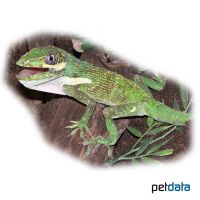Knight Anole (Anolis equestris)
| Knight Anole Anolis equestris | |
|---|---|
| Name | Knight Anole |
| Name Lat. | Anolis equestris |
| Family | Anoles |
| Family lat. | Dactyloidae |
| Order | Scaled Reptiles |
| Order lat. | Squamata |
| Origin | Caribbean |
| Habitat | Shrubs, deciduous forests |
| Diet | Insects, fruits |
| Humidity | 50-70 % |
| Behavior | ♂ territorial |
| Keeping | Pair, harem |
| Care Level | Moderate |
| Reproduction | Oviparous |
| Housing | Semi-humid terrarium |
| Life Span | 10-12 years |
| Protection | No |
| Metric Units | |
| Size | 45 cm |
| Temperature | 25-28 °C |
| Temperature Local | 35 °C |
| Housing Size | 110 x 110 x 150 cm |
| US Units | |
| Size | 18" |
| Temperature | 77-82 °F |
| Temperature Local | 95 °F |
| Housing Size | 45" x 45" x 60" |
Distribution and habitat
Ritteranolis are diurnal tree dwellers. They are native to Cuba and were introduced to Florida and Hawaii. They prefer to live in the crowns of deciduous trees and palms.
Maintenance
Minimum dimensions for the terrarium, according to the size and number of animals
| 1-2 animals | 6KRL x 6KRL x 8KRL (L x W x H) |
Head-torso length (KRL) is measured on the largest animal. For each additional animal, increase the footprint by 15%. A terrarium of e.g. L 110 x W 110 x H 150 cm is recommended, which should be placed in a quiet and vibration-free place.
They need a well ventilated terrarium with branched climbing branches and hiding places, structured back and side walls (e.g. cork covering) as well as many plants (climbing plants and epiphytes), a soft substrate of forest soil-peat mixture (15 cm deep) and a small, shallow water container as well as a drip trough. Part of the substrate should always be kept slightly moist. Several times a day the inside of the terrarium should be finely sprayed with water (humidity), but a rain or mist system is better.
| Temp. day: 25-28 °C | Temp. night: 18-22 °C | Temp. local: up to 35 °C | Humidity: 50-70 |
Thermostatically controlled floor heating is recommended. Lighting duration should be 10-14 hrs depending on the season. They need a high light intensity. Special lamps that produce the necessary heat and UV light are ideal. Daily UV irradiation is essential.
Diet
The diet consists of live insects such as crickets, crickets, grasshoppers, mealybug larvae and cockroaches, alternatively commercial ready-made food for insectivorous reptiles, supplemented with sweet fruit (bananas, strawberries or fruit pulp) and flowers or flower pollen. Adult animals can also be offered lizards, frogs and nest young mice. Wax moths should rarely be fed in very small amounts because of their large fat content. Young animals should be offered food daily, adults 4-5 times a week. Regular addition of minerals and vitamins is important. Drinking water must always be available, but is preferably taken in droplet form from leaves or furnishings.
A varied diet promotes health and prevents deficiency symptoms.
Reproduction and breeding
In males, the bulging throat pouch is significantly larger than in females.
The female buries an egg in the loose substrate several times a year. At a temperature of 26-28 °C the incubation period is 45-70 days. Since the adults regard the juvenile as food, it must be raised in a separate rearing tank. Insects are suitable as initial food for the young animals.
Important
Their adhesive lamellae on their toes allow them to move safely even on glass panes. Males have a larger, protruding throat pouch for threatening, courtship and territory marking
Adult males are very territorial and incompatible with each other.
The quality of the food can be enhanced by the addition of fruit and honey water.
The terrarium must have good ventilation without drafts and meet the species-specific needs. Measuring devices such as thermometers, hygrometers, etc. are necessary. The lighting has to correspond to the species-specific day-night rhythm and has to be placed in such a way that the animals cannot injure themselves. The terrarium should be locked in such a way that neither unauthorized persons can open it nor the animals can escape. Contamination must be removed regularly.
Further literature can be found in your pet store.
References
Text: petdata; Image: petdata
Source: BMELV (1997): Tierschutzgutachten - Mindestanforderungen an die Haltung von Reptilien; ENGELMANN (2006): Zootierhaltung - Tiere in menschlicher Obhut: Reptilien und Amphibien, Harri Deutsch Verlag
- Gemäß § 21 Abs. 5 Tierschutzgesetz idgF
